RESEARCH
Forecasting the global shortage of physicians: an economic- and needs-based approach
Prévoir la pénurie mondiale de médecins: une démarche économique fondée sur les besoins
Previsión de la escasez mundial de médicos mediante un modelo económico y basado en las necesidades
Richard M SchefflerI,1; Jenny X LiuII; Yohannes KinfuIII; Mario R Dal PozIV
ISchool of Public Health and the Goldman School of Public Policy, University of California, Berkeley, CA, United States of America
IIGlobal Center for Health Economics and Public Policy, School of Public Health, University of California, Berkeley, CA, USA
IIIDepartment of Health Statistics and Informatics, World Health Organization, Geneva, Switzerland
IVDepartment of Human Resources for Health, World Health Organization, Geneva, Switzerland
ABSTRACT
OBJECTIVE: Global achievements in health may be limited by critical shortages of health-care workers. To help guide workforce policy, we estimate the future demand for, need for and supply of physicians, by WHO region, to determine where likely shortages will occur by 2015, the target date of the Millennium Development Goals.
METHODS: Using World Bank and WHO data on physicians per capita from 1980 to 2001 for 158 countries, we employ two modelling approaches for estimating the future global requirement for physicians. A needs-based model determines the number of physicians per capita required to achieve 80% coverage of live births by a skilled health-care attendant. In contrast, our economic model identifies the number of physicians per capita that are likely to be demanded, given each country's economic growth. These estimates are compared to the future supply of physicians projected by extrapolating the historical rate of increase in physicians per capita for each country.
FINDINGS: By 2015, the global supply of physicians appears to be in balance with projected economic demand. Because our measure of need reflects the minimum level of workforce density required to provide a basic health service that is met in all but the least developed countries, the needs-based estimates predict a global surplus of physicians. However, on a regional basis, both models predict shortages for many countries in the WHO African Region in 2015, with some countries experiencing a needs-based shortage, a demand-based shortage, or both.
CONCLUSION: The type of policy intervention needed to alleviate projected shortages, such as increasing health-care training or adopting measures to discourage migration, depends on the type of shortage projected.
RÉSUMÉ
OBJECTIF: Les réussites sanitaires dans le monde peuvent se heurter à des pénuries critiques de personnel de santé. Pour guider les politiques en matière de main d'oeuvre, nous avons estimé la demande future, les besoins et la disponibilité en médecins par région de l'OMS afin de déterminer les endroits qui souffriront probablement d'une pénurie de personnel d'ici 2015, date fixée pour la réalisation des objectifs du Millénaire pour le développement.
MÉTHODES: En utilisant des données de la Banque mondiale et de l'OMS sur le nombre de médecins par habitant de 1980 à 2001 dans 158 pays, nous avons appliqué deux démarches par modélisation pour estimer les besoins futurs en médecins dans le monde. Un modèle axé sur les besoins indique le nombre de médecins par habitant nécessaire pour que 80 % des naissances vivantes soient assistées par du personnel de santé qualifié. Par ailleurs, notre modèle économique détermine le nombre de médecins par habitant qui correspondra probablement à la demande, compte tenu de la croissance économique, pour chaque pays. Ces estimations sont comparées à l'offre future de médecins, projection obtenue par extrapolation du taux historique d'augmentation du nombre de médecins par habitant dans chaque pays.
RÉSULTATS: D'ici 2015, il semble qu'à l'échelle mondiale, l'offre de médecins parvienne à équilibrer la demande économique projetée. Notre mesure des besoins reflétant la densité minimale de personnel de santé nécessaire pour assurer les services de santé de base, densité atteinte dans tous les pays sauf les moins développés, les estimations fondées sur les besoins prédisent un surplus mondial de médecins. Néanmoins, au niveau régional, les deux modèles prédisent des pénuries pour de nombreux pays de la Région africaine de l'OMS d'ici 2015, certains pays subissant une pénurie par rapport aux besoins, d'autres par rapport à la demande, voire les deux.
CONCLUSION: La nature des interventions politiques nécessaires pour atténuer les pénuries projetées, par exemple la formation d'un plus grand nombre de personnes ou l'adoption de mesures pour décourager l'émigration, dépend du type de pénurie prévu.
RESUMEN
OBJETIVO: Los logros mundiales en materia de salud pueden verse limitados por situaciones críticas de escasez de trabajadores sanitarios. Como orientación para la formulación de políticas referentes a la fuerza laboral, estimamos la demanda, las necesidades y la oferta futuras de médicos por regiones de la OMS a fin de determinar dónde es probable que se produzcan situaciones de escasez en 2015, fecha clave de los Objetivos de Desarrollo del Milenio.
MÉTODOS: Utilizando datos del Banco Mundial y de la OMS sobre los médicos por habitante entre 1980 y 2001 en 158 países, aplicamos dos tipos de modelización para estimar las necesidades mundiales de médicos en el futuro. Un modelo basado en las necesidades determina el número de médicos por habitante necesarios para lograr una cobertura del 80% de los nacidos vivos atendidos por parteras cualificadas. Nuestro modelo económico, en cambio, determina la demanda probable de médicos por habitante, teniendo en cuenta el crecimiento económico de cada país. Esas estimaciones se comparan con la oferta futura de médicos prevista extrapolando la tendencia histórica de aumento del número de médicos por habitante para cada país.
RESULTADOS: Para 2015, la oferta mundial de médicos parece estar en consonancia con la demanda económica prevista. Como nuestra medida de la necesidad refleja la densidad mínima de trabajadores requerida para dispensar un servicio básico de salud que sólo los países menos adelantados no consiguen proporcionar, las estimaciones basadas en las necesidades permiten pronosticar un excedente mundial de médicos. Sin embargo, a nivel regional, los dos modelos prevén escaseces en muchos países de la Región de África de la OMS en 2015, y algunos países podrían sufrir una escasez según las necesidades, una escasez según la demanda, o ambas cosas.
CONCLUSIÓN: El tipo de intervención normativa necesaria para mitigar esas escaseces, como una creciente formación sanitaria o la adopción de medidas para desincentivar la migración, depende del tipo de escasez prevista.
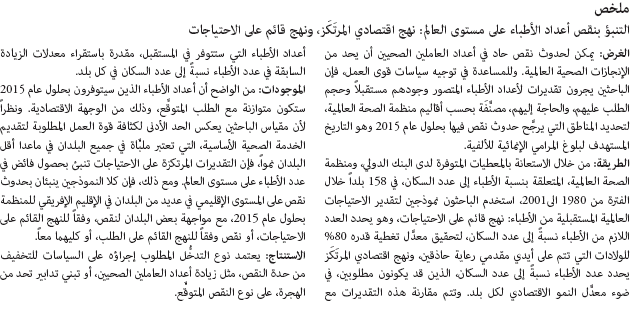
Introduction
The world health report 2006: working together for health has brought renewed attention to the global human resources required to produce health.1 It estimated that 57 countries have an absolute shortage of 2.3 million physicians, nurses and midwives. These shortages suggest that many countries have insufficient numbers of health professionals to deliver essential health interventions, such as skilled attendance at birth and immunization programmes. However, these estimates do not take into account the ability of countries to recruit and retain these workers, nor are they specific enough to inform policy-makers about how, and to what extent, health workforce investment should be channelled into training of different professions.
This paper focuses on physicians, who serve a key role in health-care provision. Using the most updated information on the supply of physicians over a 20-year period, we project the size of the future global need for, demand for and supply of physicians to year 2015, the target date for the Millennium Development Goals (MDGs).2 Needs-based estimates use an exogenous health benchmark to judge the adequacy of the number of physicians required to meet MDG targets. Demand estimates are based on a country's economic growth and the increase in health-care spending that results from it, which primarily goes towards worker salaries. We then compare the needs-based and demand-based estimates to the projected supply of physicians, extrapolated based on historical trends. Our results point to dramatic shortages of physicians in the WHO African Region by 2015. We provide estimates of shortages by country in Africa and discuss their implications for different workforce policy choices.
Methods
For illustrative purposes, we provide a stylized version of the conceptual framework we employed for forecasting physician numbers in Fig. 1. First, we project the supply in the per capita number of physicians (S) based on historical data on physician numbers for each country; this serves as a baseline against which different forecasts can be evaluated. We employ two forecasting methods. The forecast for the needs-based estimate (N) is determined by calculating the number of physicians that would be required to reach The world health report 2006 goal of having 80% of live births attended by a skilled health worker.3 The second forecasting method reflects the demand for physicians in each country as determined by economic growth (D1 and D2). With these different estimates, shortages or surpluses can be calculated. For example, by year 8, about 3.5 physicians per 1000 population will be needed compared to the projected supply of 3.0 per 1000, producing a 0.5 per 1000 shortage. In comparison, 4.0 per 1000 will be demanded according to the scenario represented by D1, resulting in a demand-based shortage of about 1.0 physicians per 1000. A different scenario can arise if supply exceeds demand, as represented by D2, resulting in a surplus. We can then multiply this estimated shortage by projected population numbers to calculate the absolute deficit of the numbers of physicians. In this illustrative case, the needs-based shortage exceeds the demand-based shortage. This framework can be applied at the country, regional and global levels of analyses, depending on the level of aggregation of physician numbers.
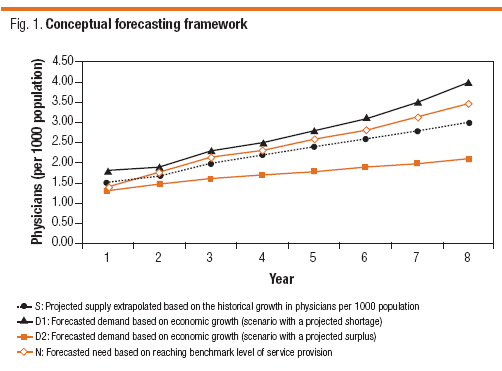
We now describe our estimation procedures more formally. First, baseline supply projections to the year 2015 were estimated using the historical growth rate of physician densities in each country. The following regression equation was run for each country for time t = {1980, , 2001}:
ln(physicians per 1000 populationt) = α0 + α1 x yeart + εt
where εt is the random disturbance term, and α0 and α1 are unknown parameters to be estimated from the model. This exponential growth model assumes that current trends in the growth of physician numbers will continue as they have historically for each country.
The needs-based approach is based on an sin1-log model that relates physician density with coverage of skilled birth attendants, weighted by population size. This model is used to identify a level of physician density below which virtually no country has achieved 80% coverage. While physicians may not necessarily be the same workers who attend live births, we can determine the overall required number of health-care workers to achieve the goal and thus gauge the subset number of physicians needed to maintain the desired level of service coverage. This approach assumes that skills mix in health service delivery remains constant. The needs-based model estimates the following equation for all countries i at time t:
sin1(% coverageit) = β0 + β1 x ln(physicians per 1000 populationit) + μi + ηt + δit
where μi and ηt reflect country and time fixed effects, respectively, δit is a random error term, and β0 and β1 are unknown parameters to be estimated from the model. This threshold density figure, along with population estimates for future years, was subsequently used to calculate the number of physicians that would be needed in each country to attain the MDG of 80% coverage of live births. We opted for the sin1 transformation because it is more consistent with statistical theory; the transformation of the dependent variable, which is a proportion, results in normally distributed responses (asymptotically). The sin1-log model also achieved the highest R² and best goodness-of-fit to the data as measured by the deviance.4 This approach is similar to that followed in The world health report 2006.
The demand-based approach utilizes gross national income (GNI) per capita as the predictor of demand for physicians per 1000 population, along with country fixed effects to account for unobservable heterogeneity across countries, weighted by population size. Previous research has shown that indicators of gross domestic product or national income are the best predictors of health expenditures, of which, labour is the principle component.59 This method has also been employed in other forecasts of physician demand.10 This approach estimates the following relationship for country i at time t:
ln(physicians per 1000 populationit) = γ0 + γ1 x ln(GNI per capitait5) + γ2 x income leveli + μi + ζit
where μi reflects a vector of country fixed effects, ζit is the disturbance term, and γ0 and γ1 are unknown parameters to be estimated from the model. GNI per capita is lagged 5 years to account for time required for economic growth to affect health-care spending and, in turn, influence changes in the health-care system and the workforce. Because GNI data were only available until 2002 at the time of data assembly, values for 20032010 were predicted using the historical growth rate. For each country at time t, the growth rate in GNI per capita was calculated as:
exp(λ1) 1
from the equation:
ln(GNI per capitat) = λ0 + λ1 x yeart + νt
where νt is the disturbance term, and λ0 and λ1 are unknown parameters to be estimated from the model. Classification of countries by income level (low, medium and high) from the World Bank was included in the demand equation as countries at different levels of development may exhibit stronger or weaker relationships between economic growth and health-care spending, depending on the complexities of the health-care system and structure of local markets.
Data
Data were compiled from several sources. The World Bank Health, nutrition and population database contains physician numbers from 1980 to 2001.11 GNI per capita (adjusted for purchasing power parity using the atlas method) for 19752002 was obtained from the World development indicators database.12 Physician numbers were updated with the most recent figures from the World health statistics 2006 database and from the OECD health data 2005 database for OECD countries.13,14 Historic and projected population numbers were obtained from the United Nations Population Division.15 We employ physician density (per 1000 population) in our analyses to account for differences in health-system size and weight all regressions by population size. Our benchmark indicator for need is the number of live births attended by a skilled health worker, also available from World health statistics 2006. We constructed a panel of 158 countries from 1980 to 2001, grouped according to WHO regional classifications (available at: http://www.who.int/about/regions).
Data were missing for some countries, either due to unavailability or differences in reporting practices. Missing data points occurring between two data points were linearly interpolated; those that were not bounded by two real data points were not interpolated. For figures on physicians per capita, missing data for up to 6 consecutive years were interpolated as some countries only reported periodically in the 22-year span of our data compilation; interpolated values comprise 35.6% of the 2819 data points for physician supply numbers used in this analysis. Because GNI per capita data are more readily available, only 4.7% of the 4238 GNI per capita data points used were interpolated. This method of treating missing data points raises concern over the robustness of our estimation results. To address this, we systematically drop countries from our sample for which the number of data points for physicians per capita are fewer than six (24 countries), fewer than seven (41 countries), and fewer than eight (63 countries). Estimated coefficients from these subsamples may differ from the main sample due to the fact that data reporting issues are more frequently encountered for lower-income countries. We carry out formal F tests of our economic demand model on these different subsamples in our robustness checks.
Results
Current distribution
We first describe the current distribution of physicians by level of health expenditures and burden of disease, displayed in Fig. 2. The size of the circle represents the proportion of world health expenditures comprised of the countries in a given region. In 2004, the WHO Americas Region registered the highest proportion of the world's health expenditures (over 50%), but had just over 20% of the world's supply of physicians, and only 10% of the global burden of disease. With a similar level of burden of disease, the WHO European Region has over 35% of the world's supply of physicians along with about 32% of the world's health expenditures. In contrast, countries in the WHO South-East Asia Region suffer the highest proportion of the global burden of disease (29%) with only 11% of the world's supply of physicians and just about 1% of world health expenditures. Similarly, the WHO African Region experiences 24% of the global burden of disease, while having only 2% of the global physician supply and spending that is less than 1% of global expenditures. Clearly, there is a dramatic imbalance in the global distribution of physicians, with countries in the WHO African and South-East Asia Regions currently facing the largest disparities.
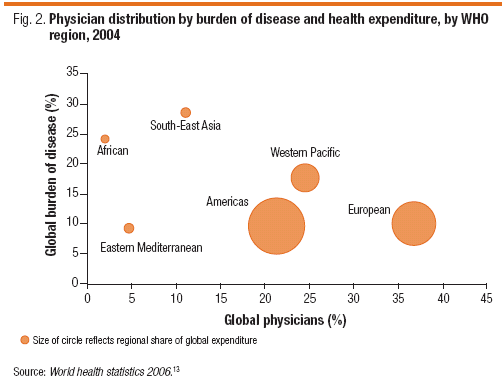
Forecasting results
The results of our analysis of the future global distribution of physicians are shown in Table 1. If current trends continue, we will have 12.7 million physicians supplied by 2015 globally. Given the standard error of our estimated growth rates of physicians for each country, this supply number can range from 11.4 million to 14.3 million (95% confidence interval). Our needs-based model projects the ratio of physicians required to achieve 80% coverage of live births by a skilled attendant to be 0.55 per 1000 population, ranging from 0.41 to 0.61 based on a 95% confidence interval (regression results in Table 2 and Fig. 3, available at: http://www.who.int/bulletin/volumes/86/7/07-046474/en/index.html). Note that this criterion of need reflects a relatively low level of health-service provision that is already met in many middle- and high-income countries. Consequently, this needs-based approach estimates that the global required number of physicians to achieve 80% coverage is about 3.8 million, ranging from 3.4 million to 4.2 million. This implies that there will be many more physicians in 2015 than are needed to reach the benchmark outcome. However, the issue of equitable workforce distribution remains. Even though the global supply of physicians exceeds that of the "need", the WHO African Region is likely to experience a shortage of physicians (about 167 000 in 2015) according to the needs-based approach.
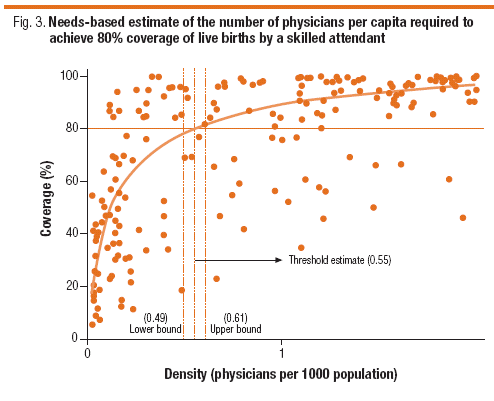
In contrast, based on projected GNI growth, there will be a global demand for about 10.8 million physicians by 2015 (regression results in Table 2). However, when we account for the 95% confidence interval, our demand-based global estimates of the number of physicians suggest a balance with the projected supply of physicians in 2015. Furthermore, countries in the WHO African, Americas and the Eastern Mediterranean Regions will likely experience surpluses of physicians of 111 000, 888 000 and 557 000 respectively in 2015. Such a projected surplus in excess of projected demand indicates that future economic growth based on the historical growth rate since 1975 may not sufficiently increase health expenditures in these areas to retain newly trained physicians. This has important implications for out-migration from shortage areas, as physicians may be attracted to areas with higher demand and higher salaries.
We further investigate whether the inclusion of countries with more missing data, and thus relatively more interpolated observations, affects the regression coefficients. We systematically drop countries with fewer than six, seven and eight actual data points from our full sample and re-ran our demand regression equation. In all cases, the coefficient for the elasticity of physicians per capita with respect to lagged GNI for the omitted category (high-income countries) is significant, does not appreciably vary across different subsamples and is precisely estimated. However, coefficients on dummy variables for middle- and low-income countries do differ across subsamples, reflecting the fact that missing data are more likely to occur for these countries. Nevertheless, all coefficients on these dummy variables are negative and significant, consistently indicating that the elasticity of physicians per capita is less sensitive to GNI per capita in middle- and low-income countries than it is in higher-income countries. Results of F tests comparing the full-sample specification to each of the restricted subsamples fail to reject the null hypothesis of no difference.
Table 3 compares the number of countries that are projected to experience shortages in 2015 from the needs- and demand-based models. We define a country as having a shortage if the projected supply of physicians meets less than 80% of the projected demand or need. Overall, we find that 45 countries will have a shortage in 2015 according to the needs-based approach, the overwhelming majority of which are located in the WHO African Region. According to the demand-based model, 37 countries are likely to experience a shortage in 2015; 15 of these countries are located in the WHO African Region, 10 in the WHO Eastern Mediterranean Region, and 7 in the who Western Pacific Region. These results for the world are graphically displayed in Fig. 4. Countries that are projected to experience demand-based shortages are also countries that will likely experience strong economic growth in the near future. For example, the demand for physicians will increase dramatically in China if the rapid economic growth experienced in recent history continues into the near future. Other countries, such as Indonesia, are projected to experience a needs-based shortage only, suggesting that even though their economies may grow strongly enough to support the supply of physicians, the overall workforce number will not be adequate to meet the needs-based benchmark of 80% of live births covered by a skilled attendant.
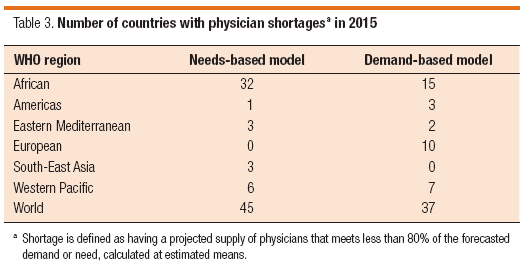
Results for Africa
In the WHO African Region, some countries will have both a needs-based and demand-based shortage. This indicates that, even though there is a critical need for more physicians, and projected economic growth will demand a larger physician workforce, the projected supply of physicians will not increase sufficiently by 2015 to achieve balance. These countries do not have the required capacity to train the numbers that will be demanded by 2015, and will likely need to depend on newly recruited workers from abroad, possibly from neighbouring countries with poor economic performance. Table 4 (available at: http://www.who.int/bulletin/volumes/86/7/07-046474/en/index.html) displays the projected need for, demand for and supply of physicians in the year 2015 for all African countries included in our analysis. For example, Kenya will need 24 000 physicians on average in 2015 (a shortage of about 18 000 physicians) and the economy will be strong enough to demand 7600 physicians on average, but the supply in Kenya is only projected to reach an average of 6100 physicians. Algeria, on the other hand, will have an ample supply of 97 000 physicians, a surplus of almost 77 000 physicians beyond what is needed and a surplus of 67 000 physicians beyond what will be demanded. In Ethiopia, we see another scenario where 53 000 physicians will be needed by 2015, but the economy will only demand about 3000 physicians, even though the supply of physicians is projected to reach about 5000. These scenarios suggest that future migration of physicians could take an increasingly regional dimension.
Discussion
Our projections suggest that, by the year 2015, the global supply of physicians will be roughly in balance with demand, while a significant surplus will arise according to the needs-based model. However, regional trends show that distributional problems will likely persist. More than any other region of the world, Africa will likely experience most of the physician shortages in 2015. Given the disproportionate burden of disease in this region, policies for increasing the supply of physicians are urgently needed to stem projected shortages. According to our needs-based target of 80% coverage of live births by a skilled attendant, a 65% increase in the physician supply in the WHO African Region will be required compared to an increase of 44% of physicians to equilibrate demand with supply. These enormous increases will require significant increases in health-care spending and active policy intervention.
Policy implications
The type of policy intervention pursued will depend on the type of shortage likely to be experienced. Given the difficulty of redistributing physicians across country borders, countries that may face only a needs-based shortage may want to consider expanding medical training programmes. For countries that face a demand-based shortage only, out-migration may be a particular concern, suggesting policies geared towards retention. Countries that face both demand-based and needs-based shortages may prefer a mixture of training and recruitment policies. Government and donor organizations should consider increasing financial support of health-care workers as a means of improving recruitment and retention.
The exact nature and extent of any policy intervention adopted will depend crucially on the characteristics of each country's health-care system and institutions. While this analysis provides a direction for where policies should be targeted, such cross-country comparisons cannot fully account for these complexities as well as other aspects of distribution (e.g. physician specialty, race/ethnicity), practice styles (e.g. work hours) and trends in the demographic characteristics of the workforce supply (e.g. ageing, gender mix), which have also been found to have important effects on health-care service delivery and access.1618 Moreover, health-worker mix is another critical factor in health-services production; further work is required in the area of predicting the future numbers of nurses, midwives and other ancillary health-care workers who will be needed and demanded. As the WHO report shows, nurses and other health workers can help to make the clinical work more productive, particularly in certain patient-care services where there are skill overlaps.19 The use of telemedicine may also have merit as a cost-effective workforce model.20,21 Limited resources clearly point to merits of these approaches.
Limitations and future directions
While we have sought to provide some indication of the numbers of physicians that will likely be required in the future, some caution is warranted in interpreting these figures. First, our criterion of need only reflects one aspect of health-care delivery; thus different numbers of physicians will be required to meet alternative normative criteria for health services. Second, our projections of demand and supply both rely on trends in either economic growth or physicians per capita, each of which are continually being affected by policy intervention. Comparable cross-country data along these dimensions are currently unavailable and consequently cannot be fully accounted for in this type of forecasting. Moreover, projections of demand will also likely be affected by other factors other than economic growth, suggesting directions for further work in refining such demand models. Given these limitations, we nevertheless believe that this exercise has been useful and informative for providing an overall sense of where physician workforce policies should be undertaken. 
Acknowledgements
We thank Teh-wei Hu, Ray Catalano and Timothy Brown for their technical expertise and advice. Steeve Ebener and his team, including Yaniss Guigoz, at WHO also provided assistance with mapping tools. We also thank the numerous seminar participants at the London School of Economics, the London School of Hygiene and Tropical Medicine, the International Health Workforce Conference, the Advanced Health Leadership Forum and the International Health Economics Association for their comments and feedback. Members of the Department for Human Resources for Health at WHO provided logistical, administrative and technical support for this study.
Competing interests: None declared.
References
1. The world health report 2006: working together for health. Geneva: WHO; 2006.
2. The millennium development goals report 2005. New York, NY: United Nations; 2005.
3. Chen L, Evans T, Anand S, Boufford JI, Brown H, Chowdhury M, et al. Human resources for health: overcoming the crisis. Lancet 2004;364:1984-90. PMID:15567015 doi:10.1016/S0140-6736(04)17482-5
4. Zar JH. Biostatistical analysis. Upper Saddle River, NJ: Prentice-Hall; 1996.
5. Cooper RA, Getzen TE, Laud P. Economic expansion is a major determinant of physician supply and utilization. Health Serv Res 2003;38:675-96. PMID:12785567 doi:10.1111/1475-6773.00139
6. Scheffler RM. Health expenditures and economic growth: an international perspective [Occasional Papers on Globalization]. University of South Florida Globalization Research Center. Nov 2004:1.10.
7. Getzen TE. Macro forecasting of national health expenditures. In: Rossiter L, Scheffler RM, eds. Advances in health economics 11:27-48. Greenwood, CN: JAI Press;1990.
8. Newhouse JP. Medical care expenditure: a cross-national survey. J Hum Resour 1977;12:115-25 10.2307/145602. PMID:404354 doi:10.2307/145602
9. Pfaff M. Differences in health care spending across countries: statistical evidence. [Medline]. J Health Polit Policy Law 1990;15:1-67. PMID:2108198 doi:10.1215/03616878-15-1-1
10. Scheffler RM. Is there a doctor in the house? market signals and tomorrow's supply of doctors. Stanford, CA: Stanford University Press; 2008.
11. Stats HNP [online database]. Washington, DC: World Bank; 2006. Available from: http://devdata.worldbank.org/hnpstats [accessed on 3 April 2008] .
12. World Development Indicators (WDI) database [online database]. Washington, DC: World Bank; 2006. Available from: http://web.worldbank.org/WBSITE/EXTERNAL/DATASTATISTICS [accessed on 3 April 2008] .
13. World health statistics 2006. Geneva: WHO; 2006.
14. Health data OECD, 2005. Paris: OECD, 2005.
15. World population prospects: the 2004 revision population database [online database]. New York, NY: United Nations Population Division; 2005. Available from: http://esa.un.org/unpp/ [accessed on 3 April 2008] .
16. Brown TT, Coffman JM, Quinn BC, Scheffler RM, Schwalm DD. Do physicians always flee from HMOs? New results using dynamic panel estimation methods. Health Serv Res 2006;41:357-73. PMID:16584453 doi:10.1111/j.1475-6773.2005.00485.x
17. Brown TT, Scheffler RM, Tom SE, Schulman KA. Does the market value racial/ethnic concordance in physician-patient relationships? Health Serv Res 2007;42:706-26. PMID:17362214 doi:10.1111/j.1475-6773.2006.00634.x
18. Liu JX, Brown TT, Scheffler RM. Are there enough minority physicians in California to go around? CPAC policy briefing, "Health research innovation: CPAC reports". Sacramento, CA; 2006.
19. Scheffler RM, Waitzman NJ, Hillman JM. The productivity of physician assistants and nurse practitioners and health work force policy in the era of managed health care. J Allied Health 1996;25:207-17. PMID:8884433
20. TeleHealth national program in support of the primary health care, Brazil. 2007. Available from: http:/www.telessaudebrasil.org.br [accessed on 3 April 2008] .
21. Vassallo DJ, Swinfen P, Swinfen R, Wootton R. Experience with a low-cost telemedicine system in three developing countries. J Telemed Telecare 2001;7:56-8. PMID:11576493 doi:10.1258/1357633011936732
(Submitted: 2 August 2007 Revised version received: 12 November 2007 Accepted: 22 November 2007 Published online: 3 April 2008)
1 Correspondence to Richard Scheffler (e-mail: rscheff@berkeley.edu).
doi:10.2471/BLT.07.046474
